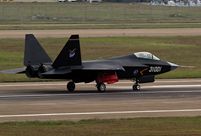 Close-up view of August Aerobatic Team
Close-up view of August Aerobatic Team
 Goddesses married in 2014
Goddesses married in 2014
 Polar region photos raise worldwide awareness of global warming
Polar region photos raise worldwide awareness of global warming
 Get off at the last stop — Beijing Subway in vision
Get off at the last stop — Beijing Subway in vision
 Top 100 beauties in the world!
Top 100 beauties in the world!
 Gallery: Who is the most beautiful one?
Gallery: Who is the most beautiful one?
 If you like autumn, put your hands in the air!
If you like autumn, put your hands in the air!
 Fan Bingbing's "Queen style" in new play
Fan Bingbing's "Queen style" in new play
 Lingerie show at 2014 Miss China
Lingerie show at 2014 Miss China
 J-10 fighters show aerobatic stunts in smog-free sky
J-10 fighters show aerobatic stunts in smog-free sky
CANBERRA, Dec. 12 -- Large numbers of kangaroos in Australia are threatening an endangered species and are eating some lizards out of house and home, a new research released on Friday has found.
Australian National University (ANU) researcher Brett Howland has found large kangaroo numbers destroy the grassland habitats of reptiles.
"When there are too many kangaroos, they over-graze grasslands until they are like a lawn, which leaves lizards with no shelter," said Howland, from the ANU Fenner School of Environment and Society.
"Just because kangaroos are native doesn't mean they don't do damage. We have to regulate their numbers if we want to retain a variety of reptiles," he said.
Howland studied lizard populations, which provide a good yardstick for the health of grasslands. Lizards depend on grass cover for both food and shelter. They are an important part of food webs, food for birds and small mammals and provide pest control by eating insects.
"Grass over 20 centimetres tall housed the greatest number of reptiles," Howland said.
"The current number of kangaroos in some of Canberra's parklands is over 300 per square kilometre. We should be controlling kangaroo numbers to at most 100 kangaroos per square kilometre in grasslands on average, and even less in treed areas."
The study found that in areas where the grass was higher than 20 centimetres, there were more than twice as many reptiles, and nearly three times as many species of reptile, than when grass was short.
"Many reptiles are under threat -- species such as the striped legless lizard are on the vulnerable list. They face possible extinction in the near future," Howland said.
"However, there are millions of eastern grey kangaroos in Australia, making them one of the most populous large mammals in the world."
Without threats from Indigenous hunters and native predators such as the dingo, kangaroo numbers have skyrocketed, Howland said.
"We are still coming to grips with managing biodiversity," he said.
"You can't lock a reserve up and throw away the key, that doesn 't work."
 20 years on: Relocated Three Gorges residents through lens
20 years on: Relocated Three Gorges residents through lens PLA HK Garrison veterans leave behind beautiful smiles
PLA HK Garrison veterans leave behind beautiful smiles Representative beauties of each province in China
Representative beauties of each province in China Chestnut girl goes viral online
Chestnut girl goes viral online Victoria's Secret Fashion Show
Victoria's Secret Fashion Show In photos: Bright and brave female soldier of PLA
In photos: Bright and brave female soldier of PLA China's charming first lady
China's charming first lady Excellent photos of Zhuhai Air Show
Excellent photos of Zhuhai Air Show China's heavyweight aircraft
China's heavyweight aircraft An old problem
An old problem Despite torture report, US escapes censure
Despite torture report, US escapes censure  Inflation hits five-year low
Inflation hits five-year low Runaway brides
Runaway bridesDay|Week|Month